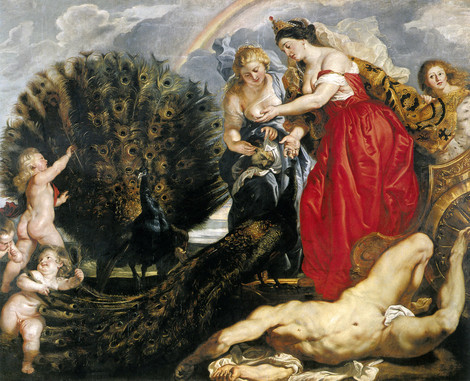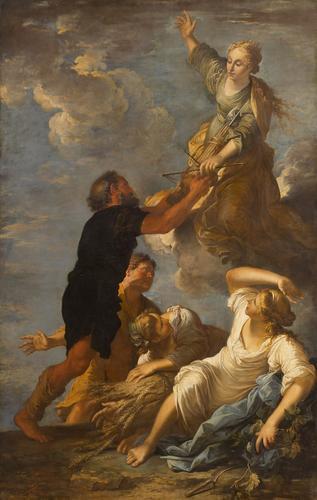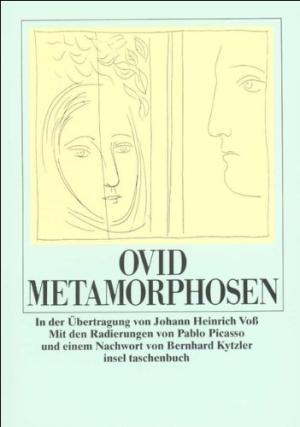 Kalliope’s
Comments
(group member since Aug 28, 2018)
Kalliope’s
Comments
(group member since Aug 28, 2018)
Kalliope’s
comments
from the Ovid's Metamorphoses and Further Metamorphoses group.
Showing 521-540 of 610
 Roger wrote: "The Rubens sketch is marvelous, but how little his apprentice had learned from him! R."
Roger wrote: "The Rubens sketch is marvelous, but how little his apprentice had learned from him! R."The Curators at the Prado must think like you, since this painting is generally not on display in the rooms of the Museum...
 Roger wrote: "
Roger wrote: "It would seem that attending lectures and seminars is almost your full-time occupation, Kalliope—or else a wonderful case of seren..."
I think both, Roger... I do spend a fair amount of my time attending Lectures and Seminars, and finding serendipitous connections amongst all these activities and my readings is part of the fun...
 Ha, yes.. when will he come back?
Ha, yes.. when will he come back?I had read about this 'cancellation'... a bit silly.
Trying to change history... not a good idea.
 Good question, Roger.
Good question, Roger.On my side, I believe that one can only give a fair judgment of a translation when one knows both languages... otherwise one can only really give an opinion on the translated text - whether it is clear, lyrical, engaging, has rhythm etc...
With Ovid I understand that as we don't even have a contemporary manuscript we are already dealing with a metamorphosed text in its origin...
I am enjoying reading two translations in two different languages. One in American English prose, aiming at clarity of text, is an excellent first approach. Then when I switch to the verse French, the text seems very different... What I notice is that in each I notice different things - of the story as well, not just because both writings are so different.
I also have the Mandelbaum which I check at times...
 For the story of Juno and Argus and the hundred eyes transposed to the tail of the peacock there is this magnificent:
For the story of Juno and Argus and the hundred eyes transposed to the tail of the peacock there is this magnificent:Rubens. 1610. Wallraf-Richartz Museum, Cologne.

The presence of the peacock is marvellous. At least from the Middle Ages onwards there was a fascination in the part of painters to depict 'iridescence' found in the peacock and also in the rainbow. Rubens, always ready to take up challenges has included both in this very original work... a very daring depiction of the decapitated body - notice how Juno is gathering the eyes to go onto her bird.
Rubens returned to Antwerp in 1609 after nine years in Italy - mostly at the Mantuan court. He clearly wanted to show back home what he had learned in Italy.
 Rereading the section on Io, I have also found a couple other pictorial renderings.
Rereading the section on Io, I have also found a couple other pictorial renderings.One by Rembrandt's teacher:
Pieter Lastman. 1618. London National Gallery

And this one I quite like with Io (almost) alone. Jove and Juno up in the clouds..
Giovanni Castiglione. Caen Beaux-Arts.

 Roman Clodia wrote: "The poem forces the reader to step back out of the text to examine how it is put together. .."
Roman Clodia wrote: "The poem forces the reader to step back out of the text to examine how it is put together. .."RC, I think it was you who pointed out that it is not actually stated that Daphne's river father Peneus is actually the one who transforms her to save her. The assumption works by juxtaposition... the technique used by cinema nowadays..
 Elena wrote: "The arc connecting episodes, as I see it, is from the beginning of time to the glory of Rome at the end. It seems like a more sensuous counterpoint to Vergil's formal foundation story of Rome,.."
Elena wrote: "The arc connecting episodes, as I see it, is from the beginning of time to the glory of Rome at the end. It seems like a more sensuous counterpoint to Vergil's formal foundation story of Rome,.."Elena, you are convincing me to read Virgil soon after this Ovid...
 Have you noticed the importance of 'hair' in Daphne's story?
Have you noticed the importance of 'hair' in Daphne's story?I quote from Mandelbaum:
Around her hair
in disarray- she wears a simple band.
..
He looks at Daphne's hair
as, unadorned, it hangs down her fair neck,
and says: "Just think, if she should comb her locks!"
...
her hair is changed to leaves,
May be to draw attention that a laurel crown will be worn on one's hair, for Apollo later says...
.. I shall always wear your leaves
to wreathe my hair.
 Jim wrote: "Having just finished Book I, a couple of thoughts: One is constantly reminded that this is simply a collection of linked short stories, all of them colorful, many of them able to stand on their own..."
Jim wrote: "Having just finished Book I, a couple of thoughts: One is constantly reminded that this is simply a collection of linked short stories, all of them colorful, many of them able to stand on their own..."Completely agree Jim. I am in my second reading - or should I say third, since I am handling three texts? -
What confused me the most during my third, and what I am paying attention to in my subsequent readings is how the various anecdotes are linked.
The notes in my book talk of the 'stepping stone' method and that the whole poem is really like a literary fugue - themes chasing each other, and some coming back with variations.
The whole being an ode to 'story telling' - and in this it could be compared to the Arabian Nights, I suppose.
 Barbara wrote: "I am struck by comments of how Story I resonates with current history. We are all coming to the reading with various backgrounds from novice (me) to scholarly."
Barbara wrote: "I am struck by comments of how Story I resonates with current history. We are all coming to the reading with various backgrounds from novice (me) to scholarly."Yes, the act of reading is a metamorphosis of the text by what the reader has in his/her mind... More transformations that keep it alive.
 Rereading the section on the Four Ages, Astraea is mentioned. I was unfamiliar with her.
Rereading the section on the Four Ages, Astraea is mentioned. I was unfamiliar with her.She is the daughter of a Titan and a Titaness...Astraeos and Ios, and is the goddess of Justice.
Ominous that she leaves the world during the Iron Age.
There is this beautiful painting by:
Salvatore Rosa. 1665. KHM in Viena.

 Czarny wrote: "Are you trying to say that the moral decadence and deterioration or technique in European painting that has now gone on for 200 years is due to the fact that the artists are no longer taking inspiration from the Metamorphoses...."
Czarny wrote: "Are you trying to say that the moral decadence and deterioration or technique in European painting that has now gone on for 200 years is due to the fact that the artists are no longer taking inspiration from the Metamorphoses...."No, at least I am not trying to say this.


 Found a print (etching) depicting the Flood, from Ovid. I did not think there would be much on this, taking precedence in the Arts the Biblical account.. thinking also that it would be difficult for an artist to distinguish between the two.
Found a print (etching) depicting the Flood, from Ovid. I did not think there would be much on this, taking precedence in the Arts the Biblical account.. thinking also that it would be difficult for an artist to distinguish between the two.Here is one in the San Francisco Fine Arts Museum.
By another great engraver,
Antonio Tempesta. 17thC.

The engraver has a good name... Tempesta... !!!
 Steve wrote: "Is there any date for us to have read Book II?"
Steve wrote: "Is there any date for us to have read Book II?"No... We have not fixed dates because we will only proceed to the next once we feel the current read has been exhausted. We had planned a S L O W read because we wanted to trace all the various artistic (literary, musical and painting&sculpture) developments and interpretations.
Some books may take longer than others. We are also aware that many people are also reading other books at the same time.
We have not started Book II yet.
 Roman Clodia wrote: "
Roman Clodia wrote: "I'd suggest we should also be attentive to who is telling each story..."
RC, yes, this is very interesting... who is telling the story..
In the Mercury and Argus story, the former tells half of the story of Pan and Syrinx, but when Argus falls asleep, Mercury stops telling the story. It is Ovid who finishes it for us.
And here are a few paintings.
Velázquez. 1659. Prado.

Rubens (again). 1636. Prado.
Io-as-cow more conspicuous than in Velázquez's.

There is at least another version by Rubens:
Rubens. 1635. Dresden Gemäldegalerie.

I like this one by:
Jordaens. 1620. Lyon Musée des Beaux-Arts.

 Roman Clodia wrote: "
Roman Clodia wrote: "And given Ovid's explicit pairing between Jupiter and Augustus (#104), I've always thought the Met a more subversive text than t..."
This is very interesting, RC... Yes, the political aspect is subtle...and we (at least I) are very much at the beginning.
I am also detecting something you pointed out, RC, and that is the humour..
One instance was the scene between Juno and Jupiter.. the latter looking a bit ridiculous... Then Jupiter, in his pursuit of Io, saying to her "Hey! Come back here! For she had run away. Not becoming to a god... Haha...
And poor Io wanting to speak and mooing instead.. Read aloud this could also become comical.
 I am amazed how many instances of what is just the First book have been picked up by artists.
I am amazed how many instances of what is just the First book have been picked up by artists.APOLLO & PYTHON.
Rubens's Sketch. 1636-1637. Prado.

The final painting is also in the Prado. Made by a collaborator of Rubens, though.
Cornelis de Vos (1586-1651). 1636/7. Prado.

We had recently an exhibition in the Prado on the oil sketches by Rubens and it is now in Rotterdam, in the Boijmans - for anyone who may be/live close.
https://www.boijmans.nl/en/exhibition...
And there is also the very interesting rendition by:
Turner. 1856. Tate.

For this, though, Turner based himself not on Ovid but on the Hymn to Apollo by the Greek Callimacchus. A much more dramatic rendition which makes us think of how Ovid 'metamorphosed' the myths.
 Desirae wrote: "I believe, that Jupiter's verdict stems upon his own fear in questioning authority; remember, he's the new ruler of Olympus. ..."
Desirae wrote: "I believe, that Jupiter's verdict stems upon his own fear in questioning authority; remember, he's the new ruler of Olympus. ..."Yes, as I pointed out in #103 is that Jupiter is the ruler only from the Silver age onwards...
He is not the 'Maker of the World'.. and after the Deluge it is Earth itself that regenerates the World..
So, this need to assure his power, to himself and to the other gods, makes a lot of sense, Desiarae... and it makes me think more of the parallel between Jupiter and Augustus.
Also, it is Themis who helps Deucalion and Pyrrha to restore the human race, not Jupiter...
So far Jupiter only means destruction and rape...
 Barbara wrote: "My copy arrived today "
Barbara wrote: "My copy arrived today "Excellent, Barbara.
You will catch up with the rest in no time.

